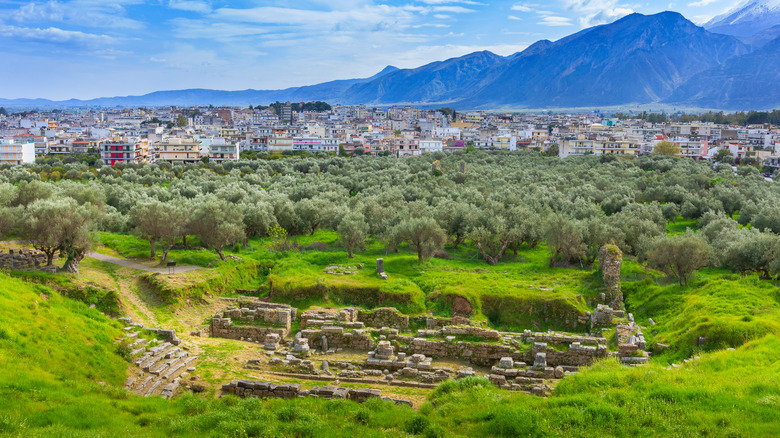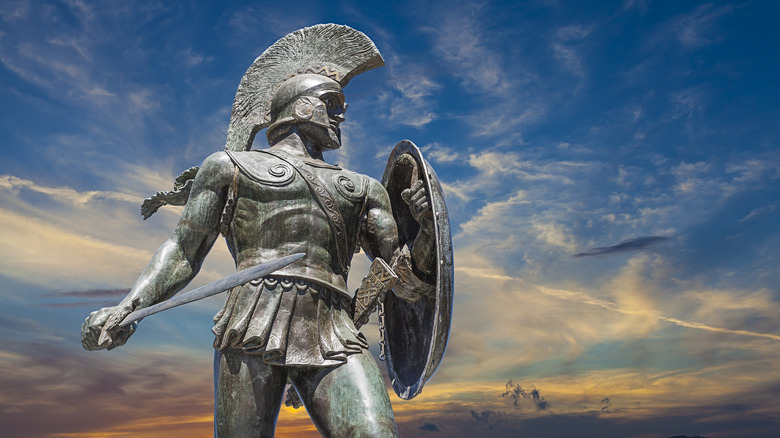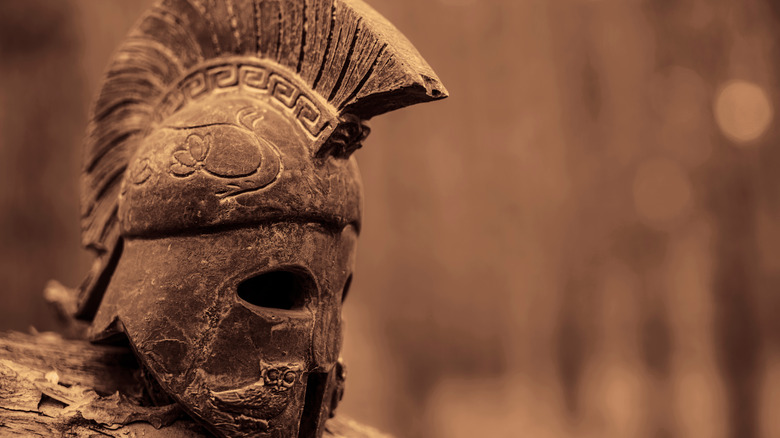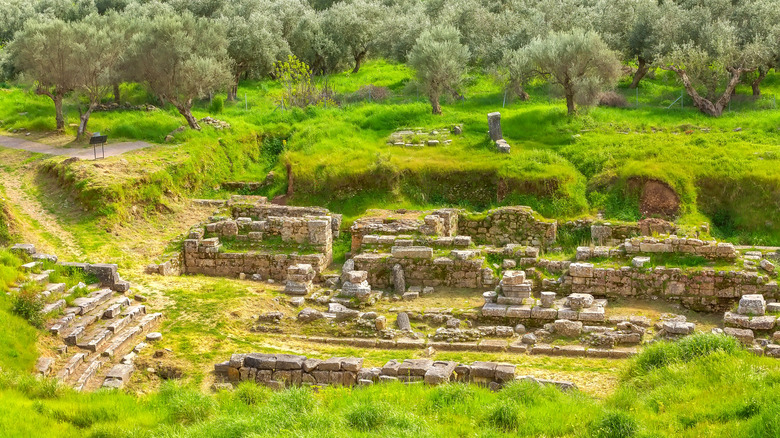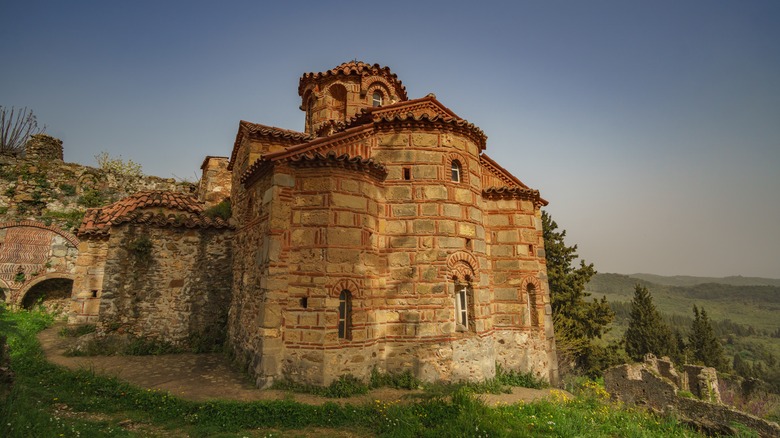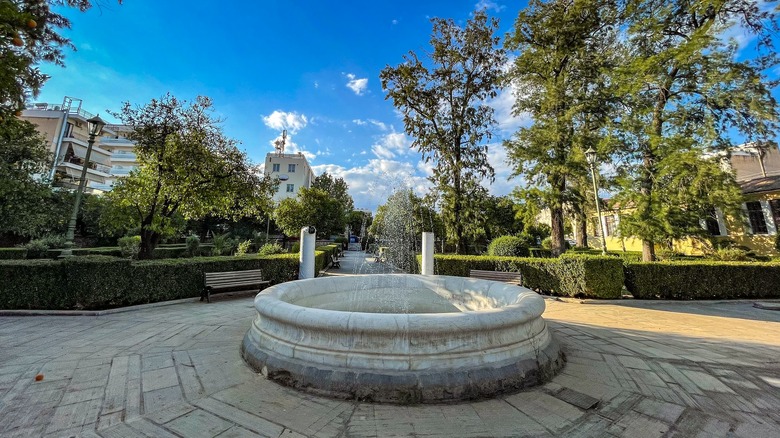What Is Sparta Like Today?
A small inland town nestled in the southeast corner of the Greek Peloponnese is home to many of ancient Greece's most famous myths and heroes. Within the citrus-and-olive-tree-filled Eurotas river valley between the Taygetus and the Parnon mountain ranges rests modern-day Sparta (per the Daily Beast). This land is the ancient kingdom of King Menelaus. His wife Helen — said to be the most beautiful woman in the world — was kidnapped by Prince Paris. The two absconded to Troy, beginning the legendary Trojan War and adventures of Odysseus, writes Visit Greece. The region was also home to the infamous Spartan military forces who fought the Persian Empire in the Battle of Thermopylae and defeated the Athenians in the Peloponnesian War.
Today's Sparta is located in the state of Laconia, which, as of 2011, had a population of nearly 90,000, according to Britannica. The Daily Beast reports that the region used to be difficult to access. However, in 2016, a new highway opened up the land of the Ancient Spartans to more visitors. It's an intersection of a bucolic contemporary Greek town made of neoclassical buildings surrounding sweeping squares and the mighty past of its ancestors, still visible in scattered ruins.
An Army of Epic Proportion
The Travel writes that Sparta made its mark as a formidable military force in the 6th century B.C. during the Persian Wars. In the battle of Thermopylae (the subject of the Zack Snyder film "300"), King Leonidas and 300 bodyguards — as well as 1,100 Boeotians — were outnumbered by the Persian army. The latter's numbers range from 70,000 to 300,000, and Leonidas's camp famously fought for three days, eventually losing due to a betrayal (per Britannica). Though a loss, this battle is considered an example of bravery in the face of grim odds.
In Sparta's town square, a statue of King Leonidas stands in front of a local soccer stadium, says Lonely Planet. Underneath the figure are the king's famous words from the battle of Thermopylae. According to Britannica, when the Persians commanded him to drop his weapons, King Leonidas retorted, "Molon labe," which translates to "come and take them."
King Leonidas is a prime example of the Spartan reputation for being of few words. Indeed, we get the English word "laconic" from "Laconia" (per the Daily Beast). According to Merriam-Webster, laconic means speaking concisely to the point of being short or brusk.
Ancient Sparta's Victory and Retreat
After eventually staving off the Persians alongside Athens, Sparta rose as one of the most powerful Greek city-states. The two powers were almost inevitably poised to oppose each other. The breaking point came from political upheaval and a natural disaster, explains The Travel. First, in 464 B.C., an earthquake devastated Sparta. As a result, the helots — the subjugated lower classes — seized the moment of uncertainty and political weakness to start an uprising. Sparta called for help from the Athenians, but Athens refused. This snub helped ignite the tension that eventually sparked the Peloponnesian War, in which Athens battled Sparta. After decades of military exchanges, Sparta came out victorious.
Yet this victory was relatively short-lived. In 371 B.C., Spartan forces lost to the Thebians. The Spartans retreated into the Achean league, never again to be a robust military presence in the Peloponnese. Protected by the mountains, the Spartans maintained their pagan religion and culture until the 9th century, when Christianity overtook the region, writes the Daily Beast. The BBC reports that the Spartans' retreat and relative isolation helped preserve one of our world's most ancient still-spoken languages. About a two-hour drive east of Sparta, in the coastal town of Pera Melana, you can find people who still speak a dialect of Greek that directly descends from the ancient Spartans called Tsakonika. Only about 2,000 people speak the language, many of whom are elderly, though efforts persist in keeping the language alive.
Sparta's Fierce Military Left Little Trace
Much like the word laconic, the English language's adjective "spartan" tells us much about the characteristics and values of the ancient warrior society. When we call something spartan, we mean disciplined or frugal, says Merriam-Webster. Both words describe how the ancient Spartans cultivated their military might. According to National Geographic, military and politics were their lifeblood. Military education for boys began at the age of 7. To allocate their time and resources to military and physical training, the Spartans subjected conquered and enslaved people, forcing them to operate the day-to-day needs of the society. Their government worked as an oligarchy, ruled by two kings so that one king could go to battle and the other could continue governing.
So mighty were the Spartan forces that they didn't fortify their city with walls. Instead, they relied on human power for defense, writes Lonely Planet. While an impressive strategy, the fearsome Spartans left little behind for future generations to experience or explore. The historian Thucydides foresaw this outcome when he wrote (per the Daily Beast), "Suppose the city of Sparta to be deserted, and nothing left but the temples and the ground plan." He continued, "Distant ages would be unwilling to believe that the power of the Spartans was at all equal to their fame."
The Ruins of a Powerful Society
While the evidence of ancient Sparta is not as impressive or intact as that of other Greek societies like the Athenians and Mycenaeans, traces of the Spartans remain. The foundations of the Spartan Acropolis and Agora are a walking distance from the contemporary town square, says Lonely Planet. Sparta's Acropolis used to hold one of the highest capacities in ancient Greece — 16,000 people (per Frommers).
While no walls remain, you can see the foundation and shapes of many important spiritual and government buildings — the Sanctuary of Athena Halkioitou, the Sanctuary of Artemis Orthia, and the Byzantine Church of St. Nikon — overgrown with wild grasses and shrubs. It's both historical and atmospheric. Like many Greek ruins, you can also see the empires and world views that left their mark on the area, with Byzantine architecture layered throughout.
Strangely, you can see some of the stonework that used to make up the walls of Ancient Sparta in the fortified town of Mystras, a 10-minute drive or hour-long walk from today's Sparta, reports the Daily Beast. In the 13th century, the Byzantine empire overthrew the Frankish empire, which controlled Sparta at the time. The Byzantines relocated the Spartan people to Mystras and constructed a fort out of ancient Greek materials remaining in Sparta. Mystras became a political, intellectual, and artistic hub for the Byzantine empire until 1460. The fort became a UNESCO heritage site in 1989.
Experiencing Modern Sparta
Today's Sparta has the modern comforts of any small Greek town — restaurants and hotels — as well as several museums that celebrate the region's history and house contemporary art. The Coumantaros Art Gallery Sparta, located in the town center, is an outpost of Athens' National Gallery. The museum includes a gallery of European paintings and a permanent collection of modern Greek artists.
Transcending both recent and ancient history, the Archeological Museum of Sparta, built in the 1870s, is one of the earliest-known archeological museums in Greece (via The Travel). According to Lonely Planet, the museum contains ancient reliefs that may represent Queen Helen and King Menelaus. Additionally, one relief might also represent Helen and Paris.
The Museum of the Olive and Greek Olive Oil traces the history of olives back to 50,000 years ago with fossilized olive leaves. The exhibits explore the connection between the olive and Greek history, identity, and mythology. Various olive oil presses dating back to the prehistoric, Hellenistic, and byzantine periods are on display. Along with hiking and outdoor activities in the nearby mountain ranges, the Caves of Diros are a day-trip distance from Sparta. The otherworldly caves full of stalactites and stalagmites have names like "The Hall of Apotheosis" and "Poseidon's Palace," writes Visit Greece. As Laconia becomes more accessible to outsiders, Sparta continues to develop its new identity as a modern destination.
